Some MUDs thrive for years thanks to dedicated management. Others fade away because there’s no one left to run them.
And every so often, one comes back online because people still find joy in what it offers.
Federation 2 was a space-fantasy MUD with cargo runs, interstellar politics, and a cooperative economy. When it shut down in 2018, a few longtime players stepped in to carry on its legacy.
Among them was Jonathan, who helped bring the game back online as Federation 2: Community Edition – or F2CE for short.
In this post, Jonathan shares what makes the game so unusual, what it’s been like keeping the galaxy running, and what’s coming next.
Also: what happens when you let players script their own puzzles, and why one Dutch friend still makes him laugh years later.
Table of Contents
- Meet Jonathan: 30% ramen by volume
- Federation 2 Community Edition at a glance
- Keeping the lights on: accessibility and modern protocols
- Lessons from running a galaxy together
- Unique challenges: vintage clients and player-built puzzles
- On the horizon: syndicates, web tools, and a Mudlet starter package
- Advice for aspiring game creators
- Extending a singular slice of MUD history
Meet Jonathan: 30% ramen by volume
Jonathan – known in-game as Cosmo – lives in California, where he works as a software engineer. At the time of the interview, he’d just returned from his honeymoon in Tokyo and joked that he was now “30% ramen by volume.” 🍜
When he’s not working on Fed2 Community Edition, he spends his free time writing fantasy stories and running a Numenera tabletop campaign. “Leading my friends on new adventures,” as he put it. Adventures that often involve creative character deaths.
His first foray into MUDs
Long before Fed2, Jonathan’s first MUD was Federation, the original version of the very game he helps maintain today.
“It had spaceships, galactic commodity exchanges, puzzles, time travel, and so much more,” he said. “It was one of the few games available on AOL in the ’90s. I was instantly hooked.”
Later, he discovered Rapscallion, a Mac MUD client that introduced him to NANVAENT, a traditional fantasy-themed MUD. He joined the staff and got his first taste of game development by working on areas, guilds, and quests.
(If you have a moment, I you should check out the Nanvaent website. It’s a bit of a hoot. Not unlike Jonathan himself.)
“I credit MUDs with sparking life-long interests in computers, writing, and design,” he told me. “I can trace a line from them to my day job today: arguing with computers (sometimes called ‘software engineering’).”
For Jonathan, that mix is the core of what makes MUDs special.
“MUDs occupy a unique intersection between writing, programming, socializing, and fun that I find fascinating. I don’t think that mix has been replicated by any other medium,” he said. “I hope that MUDs will be around long after the last gnome leaves Ironforge.”
Federation 2 Community Edition at a glance

When Federation 2 shut down in 2018, it could have disappeared like so many other MUDs. Instead, a small group of longtime players secured permission from the owners and got the source code so they could launch what’s now known as Federation 2 Community Edition.
The current game is managed by a small team of fans including Jonathan/Cosmo, Preston, and Rick/Smitty.
If you’ve never played Federation 2, here’s the gist:
It’s a space-themed MUD built around interstellar trade, planetary ownership, and an economy that works best when players cooperate with each other.
“You start simple: your first goal is to get a spaceship permit and take out a loan for a spaceship,” Jonathan explained.
“You’ll haul cargo around the solar system to pay off your loan, then you’ll have a brief stint as a courier delivering valuable packages, and soon you’re earning profits for yourself by buying and selling on the galaxy’s commodity exchanges.”
From there, the galaxy opens up.
Players can incorporate businesses, build depots and factories, and even launch IPOs to turn their companies public. Some take a stake in other players’ businesses or collect dividends from them. It all leads toward planetary ownership and star system design.
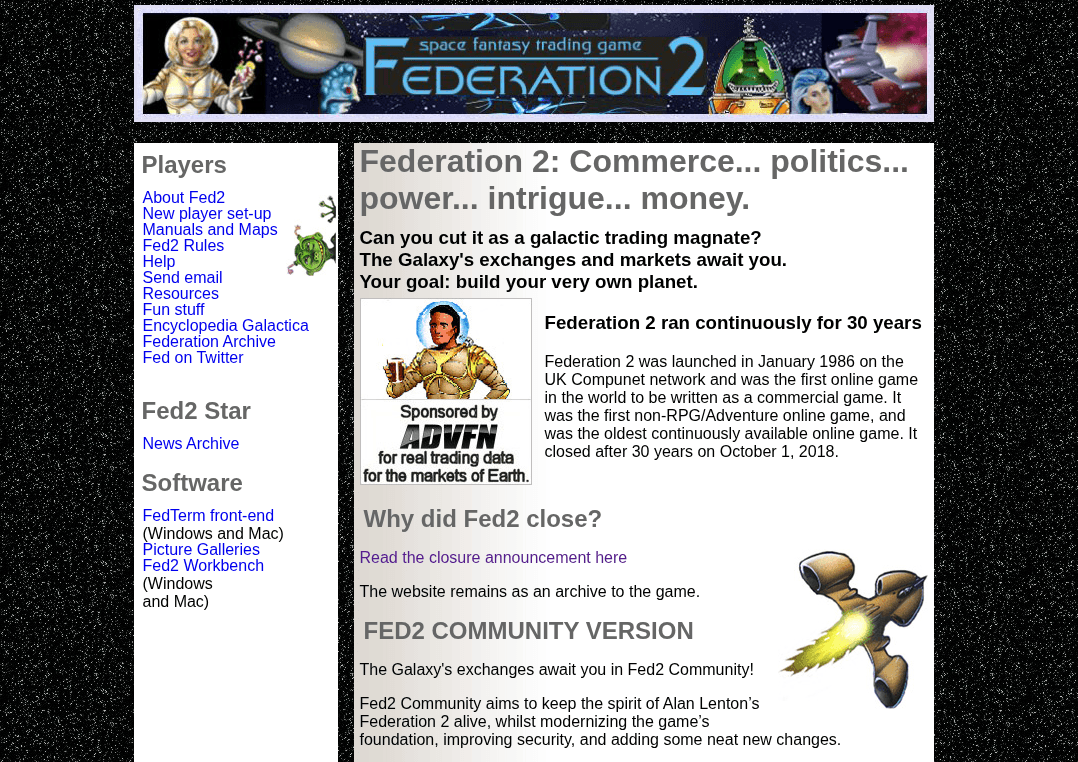
“I think what makes F2CE special is that how you play the game changes as you climb the ranks,” he said. “At the highest rank, Plutocrat, you wield immense economic power as you manage your own cartel of star systems.”
But the real hook isn’t the ranks – it’s how they’re designed to work together.
“At every rank, you’ll always do better by collaborating with other players. Cargo jobs pay better on player planets, which also tend to offer better prices when you’re buying and selling commodities or looking for a place to build your factories. As a planet owner, banding together with other star systems leads to greater economic prosperity for all.”
It’s not unusual for a MUD to have cooperative mechanics, but Fed2 is different. Cooperation is at the game’s very core.
“In my experience, it’s exceptionally rare for a MUD to be fundamentally cooperative, not adversarial, at every stage,” said Jonathan.
Speaking of rare, here’s a neat little feature of Fed2: when asked to choose your race during character creation, you can put human, cyborg, vulcan, grue… or anything you want, really. You can even invent your own term!
Keeping the lights on: accessibility and modern protocols
When a MUD has been around in some form since the ’90s, there’s going to be some technical upkeep required – and F2CE is no exception.
Jonathan and the team have been gradually modernizing the code so that it works with today’s clients, devices, and access needs.
“We’ve added support for modern telnet standards like GMCP, MCCP, MSSP, NAWS, TTYPE, SGA, and a host of other protocols,” he told me.
Protocols like these help MUDs talk more smoothly with today’s clients.
For example, GMCP lets the game share extra info – like your character’s location, health, or inventory – so that your game client can display it in a status window or on a map.
MCCP compresses text so it loads faster. NAWS and TTYPE help the game figure out your screen size and terminal type so the output displays cleanly.
All of it adds up to a game that’s easier to read, easier to navigate, and more flexible for tools like screen readers or mappers.

Even so, Jonathan doesn’t see his main role as a coder in Fed2. Rather, he’s more like a guide:
“My role is to keep the galaxy humming along smoothly,” he said. “I help new players take their first steps into the game, and planet owners to manage their planet and system files. You know, just galactic things.“
Accessibility in Fed2CE
Beyond protocol support, the team has added several accessibility tweaks to make the game easier to navigate – especially for players using screen readers or nontraditional setups.
“Every room displays a list of exits, and players can choose to enable a prompt,” said Jonathan. The prompt shows key info like current funds and gives players more control over how much text appears in the output at once.
“Players can also go into brief mode, which suppresses room descriptions entirely and switches the list of exits to a minimal format. These help make movement and player status more accessible to everyone.”
There’s also an optional NAVCOMP (navigational computer) ship upgrade, which allows players to travel between planets in the solar system using a single command. That means less repetitive movement spam and fewer steps to remember when you’re trying to get from point A to point Z.
The website is a trove of resources, as well. There, you’ll find instructions for getting started, including cargo pickup and delivery directions for each planet in the solar system.
You’ll find planet maps with included text descriptions.
There’s even a collection of solid (and humorous) FAQs.
These things won’t wow anyone in a screenshot, but they do reflect a real effort to make the game more usable – for new players, longtime returnees, and anyone who doesn’t interact with MUDs the way they used to.
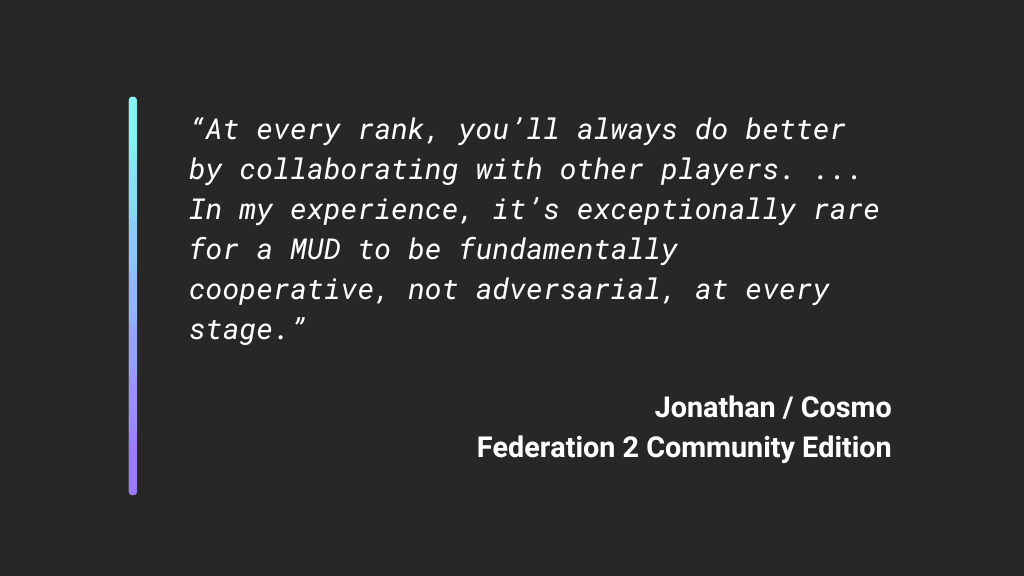
Lessons from running a galaxy together
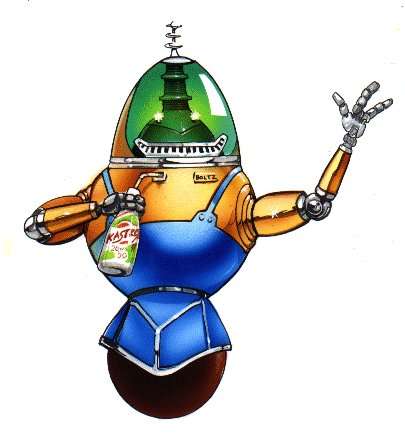
Rebuilding and running F2CE hasn’t just been a technical project for Jonathan and the team. It’s been a crash course in community management, player behavior, and the unexpected ways people interact with a game that’s been around for decades.
One of the biggest lessons?
You can’t always predict what players will want – or not want.
At one point, the team considered adding an in-game mail system. The idea was simple: let players send messages to each other, even if the recipient was offline.
Sounds reasonable, right?
“[It] was almost universally despised,” said Jonathan. “It turns out that people don’t want another email inbox!”
Lmao. Fair enough.
That particular proposal was dropped, but not every idea flops. Some land better than expected, especially when they come straight from players.
For example, F2CE’s event engine lets players script their own interactions and puzzles on their planets, sometimes with surprising complexity.
The team decided to formally recognize those efforts by treating player-built puzzles the same as “official” content when it comes to certain optional rewards at higher ranks.
“Some players like that the puzzles are optional,” said Jonathan, “and the builders appreciate their work being recognized.”
That recognition goes a long way. The knowledge that your planet’s puzzles count – that they’re “real” in the eyes of the game – motivates players to keep building, refining, and experimenting.
Making sure returning players have a place
Another lesson came from the game’s long history. Many players who rediscovered F2CE had played the original Federation or Fed2 years ago, back when it was still subscription-based or when the “slithies” were still paid perks.
(These days, the game is entirely free. You never have to pay for slithies, and as the website notes, there’s no way to pay or donate even if you wanted to!)
Rather than make these returning players start over, the team built tools to restore their previous ranks and systems.
“Some players have returned to (or rediscovered) F2CE after 10, 15, or even more years away from Fed2,” said Jonathan. “We’ve worked on tooling that makes it easy for these players to jump to their old ranks, with their systems and planets fully intact.”
That small act of continuity had ripple effects. Veteran players who returned to find their old planets waiting for them were more likely to stay – and more likely to help out newer players who were just getting started.

According to Jonathan, it created a kind of informal mentorship system. Not one enforced by code or rewards, but built into the culture of the game itself.
And that seems to be one of the quiet strengths of F2CE: players can come back years later and jump right back into the game.
Unique challenges: vintage clients and player-built puzzles
Supporting a 30-year-old game means dealing with more than just old bugs. Sometimes the biggest hurdles come from the features players love the most.
“Fed2 has its own desktop client app, FedTerm, which dates to the early aughts and is still used by some of our players,” said Jonathan. “FedTerm has an integrated mapper and custom displays for character stats and ship details, all powered by a proprietary XML-based protocol.”
That protocol was built specifically for Federation. It’s what lets FedTerm display maps, windows, and sidebars that no generic MUD client can reproduce. And for players who’ve been using it for decades, it’s an essential part of the experience.
The challenge, of course, is that FedTerm was never designed for modern systems. It’s not open source, and it doesn’t receive regular updates. Keeping it working – while adding support for newer protocols and standards – takes careful planning.
The team’s goal has been to keep FedTerm functional for those who rely on it, without making it a requirement for everyone else.
Keeping player-built content stable
Meanwhile, on the builder side, the challenges are of a different flavor entirely.
The same event engine that lets players build elaborate puzzles and interactions is also one of the trickier parts to manage. It keeps the galaxy feeling alive, but it’s a recipe for disaster if someone writes a buggy event.
“F2CE is a galaxy of player-designed planets and systems, which have the full power of the game’s event engine available to them,” said Jonathan. “Player-built puzzles and events, if not handled properly, can bring the entire game down.”
To avoid that, the team built a two-part safety net:
- First, they created a validation system that checks player-authored events before they’re allowed live.
- Second, they run a test server where builders can preview their planets and events in a sandbox environment before pushing anything to production.
It’s not a simple setup, but it’s necessary. It lets players keep creating ambitious, customized content while keeping the rest of the galaxy stable and online.
F2CE isn’t just preserving what Federation used to be – it’s actively giving players more freedom, while putting the right guardrails in place to keep that freedom from knocking the whole galaxy offline.
A tricky balance to get right. But so far, it seems to be working.
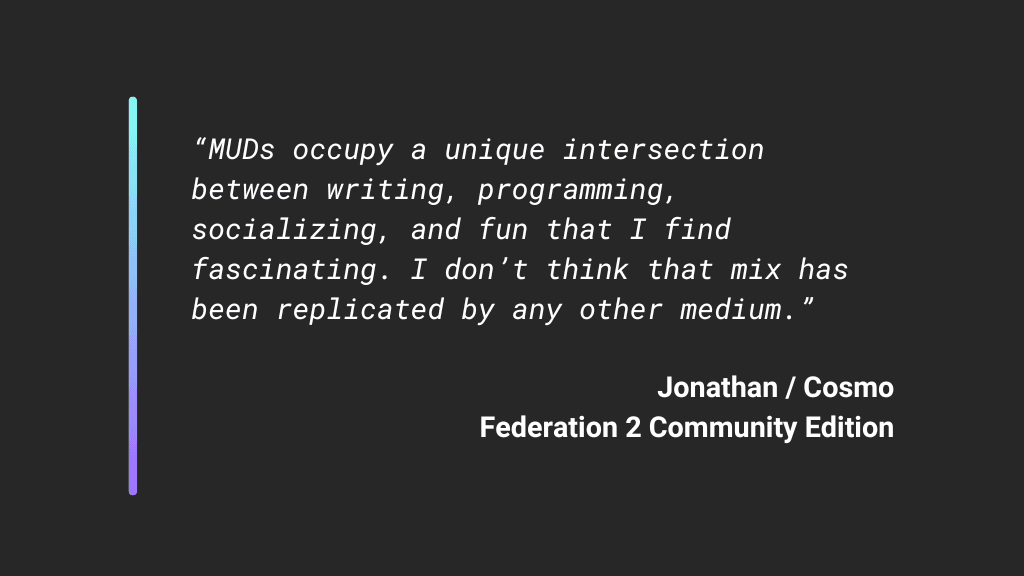
On the horizon: syndicates, web tools, and a Mudlet starter package
Even after all the modernization work and feature additions, the team behind F2CE wants to keep going. There’s still plenty they want to build – and plenty they’re hoping others will help with.
One big piece is already in place: a full database overhaul. It’s not flashy, but it lays the groundwork for better tools and new features down the line.
“Our new backing database could be a way for players to authenticate on the website,” said Jonathan.
That alone would be a major change, but it’s also a stepping stone toward revamping some of the game’s oldest tools.
Right now, many of the planet-owner utilities – like the event editor, validator, and location manager – are still legacy Windows apps. Some are nearly 20 years old and can be tricky to run, even on modern Windows systems.
“We’d like to make all that functionality available on the website and accessible to everyone,” Jonathan explained.
That would mean new, web-based tools to let builders manage their systems, update descriptions, test events, and more – all without having to install anything or run software in compatibility mode.
A new Syndicrat rank?
While those infrastructure projects are on the roadmap, they’re not the only things being considered. Jonathan also hinted that the game’s current ceiling could eventually be raised:
“There are some references in the code base to a Syndicrat rank, which could be the next step after today’s max rank of Plutocrat.”
The idea is compelling. The rank could represent a player who leads a syndicate, a kind of meta-cartel composed of multiple planetary cartels. It would be a natural progression for players who have already reached the top of the current system and want something bigger to work toward.
Nothing’s set in stone yet, but Jonathan admits the possibilities have been fun to explore. And if it ever gets implemented, the Syndicrat rank could add another layer to the game’s already complex, player-driven economy.
Mudlet starter package
On a more practical level, one of the near-term goals is building a Mudlet starter package for new players connecting with that client. (Yes, please!) Mudlet is one of the most popular cross-platform MUD clients, and it already supports scripting, mapping, and protocol handling.
“We’d love to formalize a client package for the Mudlet MUD client app,” said Jonathan. “It’d include a mapper, some chat filters, and other nifty tools, and it can be automatically installed when players connect with Mudlet.”
The goal is to make onboarding easier – especially for people new to MUDs or returning after a long break. A pre-configured setup would lower the learning curve and let players start exploring and trading right away.
Advice for aspiring game creators
Before we wrapped up, Jonathan offered up some straightforward advice for anyone thinking about starting a MUD of their own.
It’s tempting, he pointed out, to jump straight into solving every problem with more code. But then you can end up with two problems instead.
His take? Get curious about people, first. Read often and widely. Sociology, psychology, economics, philosophy – these areas of study contain answers to valuable questions that can help you solve the right problems.
What makes a game fun? Why do some people thrive on puzzles while others just want to grind for resources or XP? How can your text actually make sense to the widest audience possible?
His personal inspirations include the Discworld books by Terry Pratchett (see also: Discworld MUD), Richard Bartle’s MUD Institute articles, and even Matt Levine’s finance newsletter for the way it makes complex ideas approachable.
And maybe the biggest takeaway: be honest about your goals.
“Make sure you’re starting a MUD project for the right reasons. Unlike your company in F2CE, your MUD is probably not going to launch an IPO that makes you a ton of money,” he said.
Extending a singular slice of MUD history
Despite how it may seem from the ambitious roadmap, Jonathan didn’t get involved with F2CE to overhaul Federation. He just wanted to share the joy he’d found there for so long.
“I’m grateful for the many decades of fun it’s given me,” he said. “I hope it’s around for many years to come. And I am eternally grateful to Alan Lenton, the creator and programmer behind Federation and Federation 2. Not only did he create a truly unique game that has stood the test of time, but he has also been gracious enough to allow us to continue his legacy through F2CE.”
By the way, Jonathan also built MUDRammer, the (now-retired) mobile game client. For years, it was the go-to app for iOS users. I never used it myself, but I knew plenty of folks who did.
When I asked where the name came from, I half expected a joke about network protocols, but it turns out the name came from a Dutch friend of his who plays a character called “Mudrammer.”
“It is a ridiculous and silly name,” said Jonathan, “but it still makes me 😆.”
Seems about right. Not every project has to stick around forever – sometimes it’s enough that it still makes you smile when you think about it.
Others, like F2CE, have some life in them yet, and I, too, hope that F2CE is around for many years to come.
A huge thank-you to Jonathan for taking the time to share what’s happening behind the scenes at F2CE – and congrats on his recent nuptials!
If you’re curious to give F2CE a try, you can connect to play.federation2.com on port 30003, or check out federation2.com for more info. Whether you’re new to the galaxy or dusting off your old ship, you’ll be in good company.
And like so many MUD projects, F2CE runs entirely on volunteer time and passion. If you’re a builder, coder, writer, or just a curious player with an idea or two, there’s room to get involved. You can reach Jonathan / Cosmo and his team at support [at] federation2 [dot] com.
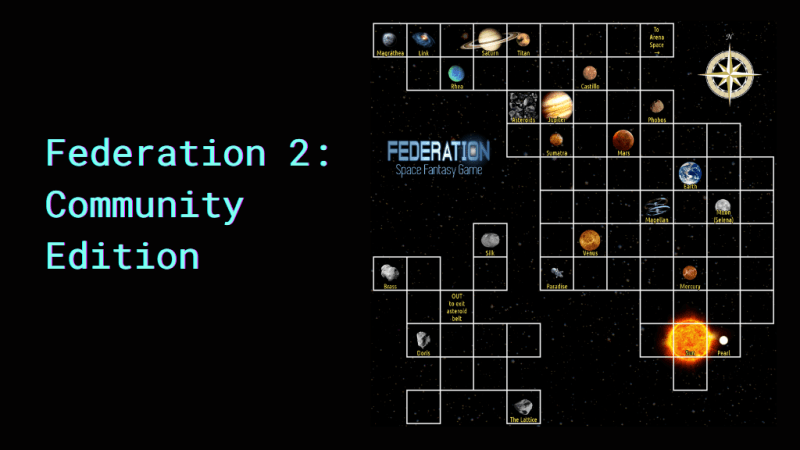


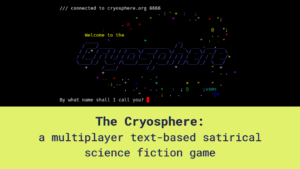
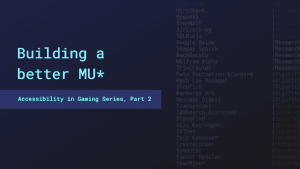
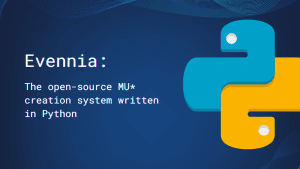
Leave a Reply to Andruid Cancel reply